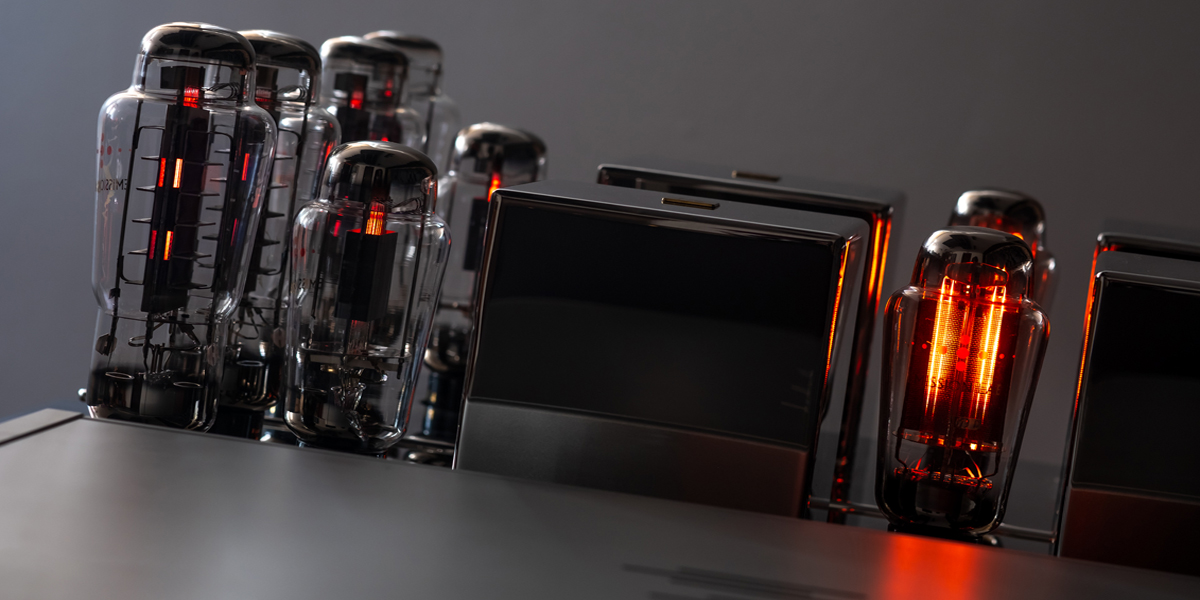Audio Phonique’s portfolio branches out into several product tiers with the Statement line as its brightest star. After reviewing the group’s DAC and preamp it’s time to sample Audio Phonique PSE1605 mono amps. Enjoy!
Parallel SET excellence
To say that an audio company entered the industry with a bang may sound like a cliché or an exaggeration, reviewers’ lingo is full of these after all. Every now and then starting a story in this manner feels justified. Today is that time. The two founders of the local manufacture Audio Phonique – Wojciech Murawiec and Maciej Lenar – opened up their roster with a DAC and pre priced at €40k each. That’s no spare change. Quite a few people would think that a newcomer company with aspirations this bold won’t last long without pursuing more affordable stuff. Fret not, Maciej and Wojtek make that too. However, exotic hardware is their costly core business that keeps them financially afloat, relaxed about the future and these days also smiling from ear to ear. Really.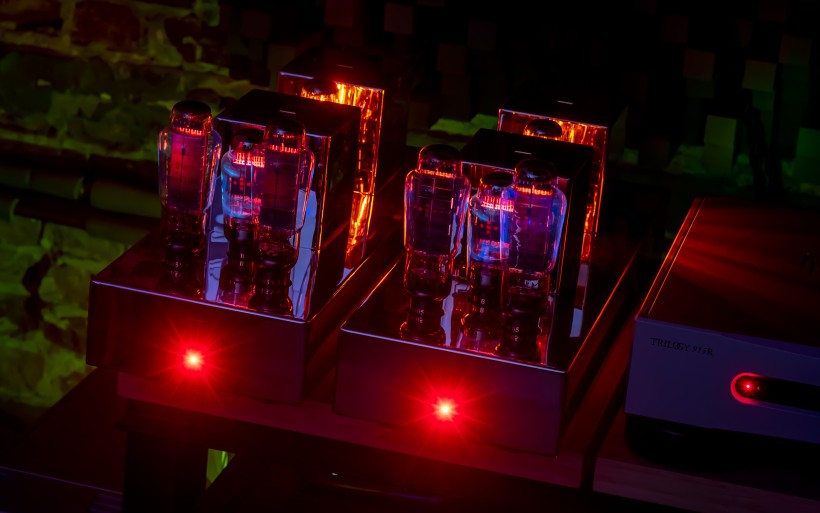 Investing is Wojtek’s primary skill, so he knows more than well that building a brand takes money and time. Pour enough of both into a project and the odds are that eventually it will flourish. During one of our chats somewhere in early 2022 he explained that this method hasn’t yet failed him. Apparently good things come to those who wait and invest. Maciej who visited me several weeks ago had some news to share on the subject. He happily reported that recently Audio Phonique has been the hot topic largely in the US and this trend is still ongoing, which makes him a very busy bee. The Munich gig just around the corner doesn’t make the man’s life any easier either. Then again, a long list of orders and pre-show hassle are, well, nice problems to have. After all, the local Warsaw event and HighEnd Munich are the mandatory stops if you’re in the biz. The latter turned out to be the reason for Maciej’s recent drop by, securing some press coverage prior to exhibiting is a smart move. Since I’ve already reviewed top shelf Audio Phonique pre and DAC, the opportunity to sample the company’s PSE1605 mono amps from the Statement range was in the cards.
Investing is Wojtek’s primary skill, so he knows more than well that building a brand takes money and time. Pour enough of both into a project and the odds are that eventually it will flourish. During one of our chats somewhere in early 2022 he explained that this method hasn’t yet failed him. Apparently good things come to those who wait and invest. Maciej who visited me several weeks ago had some news to share on the subject. He happily reported that recently Audio Phonique has been the hot topic largely in the US and this trend is still ongoing, which makes him a very busy bee. The Munich gig just around the corner doesn’t make the man’s life any easier either. Then again, a long list of orders and pre-show hassle are, well, nice problems to have. After all, the local Warsaw event and HighEnd Munich are the mandatory stops if you’re in the biz. The latter turned out to be the reason for Maciej’s recent drop by, securing some press coverage prior to exhibiting is a smart move. Since I’ve already reviewed top shelf Audio Phonique pre and DAC, the opportunity to sample the company’s PSE1605 mono amps from the Statement range was in the cards.
Since Maciej is practically my neighbor, logistics from his place to mine were quick and easy. This time around however he had with him a massive robust custom-made flight case that showed nearly 75kg on the scale, so a proper workout for the two of us. This costly chest is the manufacturer’s standard for the Statement tier and necessity. Maciej explained that it was designed it to withstand all types of damage during transportation and contain the full set. When shipping outside the EU, one box lost or stuck at a customs clearance out of two dispatched is the last thing an audio company wants to experience. Being practical pays out, even if some elbow grease is required every now and then. The bottom level of the case housed two PSE1605 mono amps snug in-between foamy liners, while the removable upper ply floor lined with felt contained a manual and eight Emission Labs tubes each in its own box.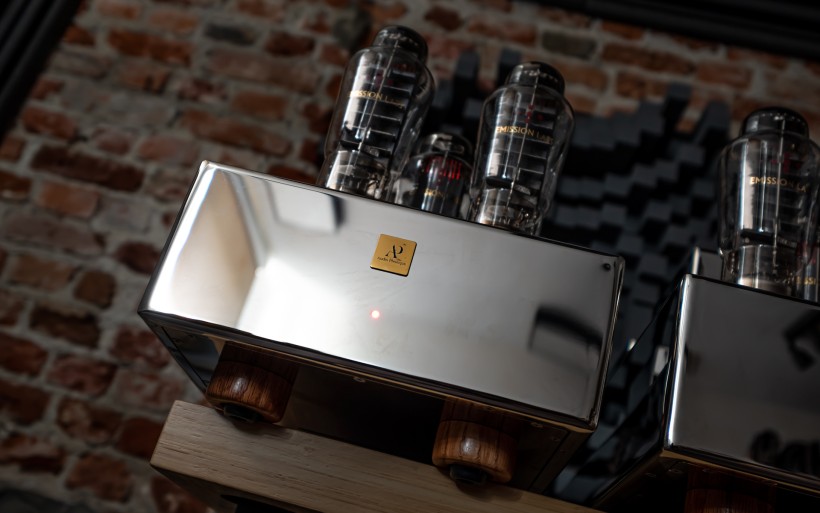 Maciej is locally known as SET aficionado and his PSE1605 mono amps accurately reflect that. Each measures (W x D x H) 240 x 600 x 250/80mm with/without tubes installed and weighs 25kg. These are heavy suckers to lift and move around and unusually long at that. Regular 50cm-deep shelves will barely do the trick, but more about that later. The on-site specs show 100kΩ input impedance, 5Vrms input sensitivity, 500W constant power draw, 20dB gain, self-noise at 1.5mVrms and 40W power output into 4/8Ω. Damping factor well below 100 is only natural considering the product’s zero-feedback SET pedigree. Each mono incorporates four Emission Labs tubes; a 274B full-wave rectifier, 20B driver and twin 1605 DHTs as output devices used in parallel. These power tubes are rated at 30W, so one could squeeze 60wpc out of them. Maciej’s circuit limits their output to comfortable 20W to keep distortion below 1%. Besides, 40wpc is already very generous for a pure class A SET affair. Should you wonder about the PSE bit in today’s name, it unfolds into Parallel Single-Ended, while 1605 represents the designer’s DHTs of choice.
Maciej is locally known as SET aficionado and his PSE1605 mono amps accurately reflect that. Each measures (W x D x H) 240 x 600 x 250/80mm with/without tubes installed and weighs 25kg. These are heavy suckers to lift and move around and unusually long at that. Regular 50cm-deep shelves will barely do the trick, but more about that later. The on-site specs show 100kΩ input impedance, 5Vrms input sensitivity, 500W constant power draw, 20dB gain, self-noise at 1.5mVrms and 40W power output into 4/8Ω. Damping factor well below 100 is only natural considering the product’s zero-feedback SET pedigree. Each mono incorporates four Emission Labs tubes; a 274B full-wave rectifier, 20B driver and twin 1605 DHTs as output devices used in parallel. These power tubes are rated at 30W, so one could squeeze 60wpc out of them. Maciej’s circuit limits their output to comfortable 20W to keep distortion below 1%. Besides, 40wpc is already very generous for a pure class A SET affair. Should you wonder about the PSE bit in today’s name, it unfolds into Parallel Single-Ended, while 1605 represents the designer’s DHTs of choice.
Audio Phonique PSE1605 is visually conservative considering the breed, while its highly reflective chassis nets brilliant looks in busy spaces. These shiny enclosures with gently trimmed edges look as if they were either cast or machined from a solid billet. Not. They’re the result of a far more intense labor. Sheets of 2mm-thinck 316L surgical steel had to be cut to size, bent, welded and polished by hand to achieve the pretty much flawless mirror-like surface. In my previous Audio Phonique stories Maciej already explained how much of a horror the manufacturing process of these parts is. Finding a local shop capable of doing the job just right resulted in many dead ends and took a while. Surgical steel was the top choice because a 2mm plate of this non-corrosive non-magnetic material does what its five times thicker aluminium equivalent would, yet still is harder, weighs more and has better self-damping properties. It also costs four times as much, which largely contributes to the PSE1605’s staggering retail of €80’000/pr.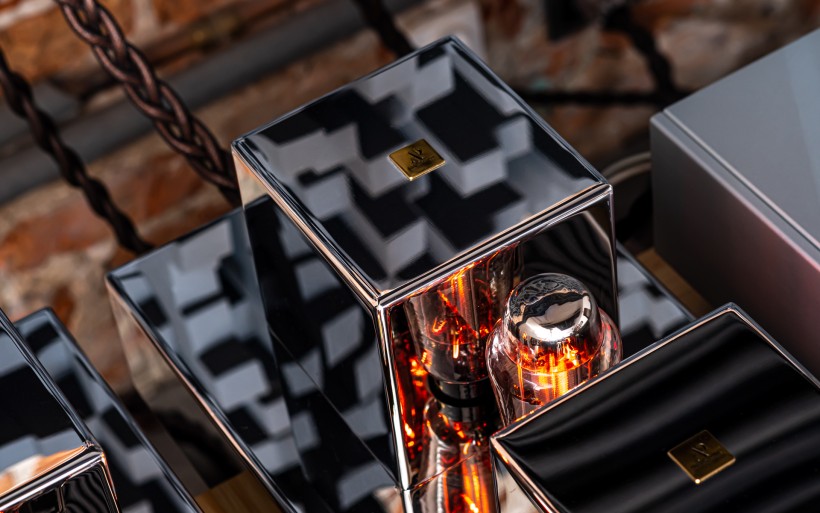 Those unfamiliar with the SET kind may find Audio Phonique PSE1605 visually peculiar; rather old school if not dated. However, these monos look the way they do because their topology says so. Their elongated narrow enclosures are the effect of distributing all key components with the shortest and cleanest signal path in mind. The external cube near the business end houses a large amorphous speaker transformer, while the other shiny compartment contains two power transformers which separately feed output tubes and all else. Since the EML 274B rectifier for the EML 20B driver has to sit somewhere in-between these protruding boxes, Maciej had decided that a long narrow frame for all the key ingredients made more sense than a wider shorter structure. I agree. That way his monos aren’t visually intimidating in spite of their large footprint.
Those unfamiliar with the SET kind may find Audio Phonique PSE1605 visually peculiar; rather old school if not dated. However, these monos look the way they do because their topology says so. Their elongated narrow enclosures are the effect of distributing all key components with the shortest and cleanest signal path in mind. The external cube near the business end houses a large amorphous speaker transformer, while the other shiny compartment contains two power transformers which separately feed output tubes and all else. Since the EML 274B rectifier for the EML 20B driver has to sit somewhere in-between these protruding boxes, Maciej had decided that a long narrow frame for all the key ingredients made more sense than a wider shorter structure. I agree. That way his monos aren’t visually intimidating in spite of their large footprint.
Each PSE1605 sits on four wooden pucks with rubber washers and the upper 50x50cm shelf of my rack barely accepted them both. Width wasn’t an issue as these are narrow devices, but photos show how their footers barely touch the surface underneath, so a deeper rack would’ve been an asset. This is not a con, just something to keep in mind. Besides, if I were the owner of these monos, I’d have them on the floor just as most people would. Moving on, a single red LED on the front of each PSE1605 engages upon finishing the soft-start procedure that lasts less than a minute. Narrow perforations on the underside support heat dissipation. The rear features WBT binding posts with separate positives for 4/8Ω loads, a fused IEC inlet with the main on/off rocker and one of each RCA and XLR inputs. Just to be clear, the PSE1605 is a single-ended device and the unit provided by Maciej is the first they ever made. The balanced socket in it is an inactive remnant of the original design that was abandoned, so paying customers won’t see it. Upon learning that I had to ask about the SE topology of the company’s Statement monos in the context of the lineup’s fully differential pre and DAC. Maciek explained that the PSE1605 is the flagship amp… for now. Something even fancier, bolder and inherently balanced already is in the works. Fair enough. During its time at my place the PSE1605 remained perfectly stable, but I expected nothing less after experiences with its posh siblings. Just to state the obvious, this design gets very hot very quickly especially in the tube area, so providing enough space around each its enclosure is a must. Shiny dress code also means awesome looks right past unpacking and lots of visible dust specks one day later. It’s also a major fingerprint attractor, so regular cleaning is a thing to keep today’s twin-chassis stunner pretty. I think that it really deserves this effort.
During its time at my place the PSE1605 remained perfectly stable, but I expected nothing less after experiences with its posh siblings. Just to state the obvious, this design gets very hot very quickly especially in the tube area, so providing enough space around each its enclosure is a must. Shiny dress code also means awesome looks right past unpacking and lots of visible dust specks one day later. It’s also a major fingerprint attractor, so regular cleaning is a thing to keep today’s twin-chassis stunner pretty. I think that it really deserves this effort.
Although the manufacturer had nothing against me opening up the PSE1605, I didn’t dare. An enclosure like that develops visible marks upon just looking at it, so turning it upside down and unbolting the bottom plate was a risk I wanted to avoid. Besides, Maciej wasn’t secretive about internals. EML 1605 DHTs used in the parallel configuration are in line with the SET topology’s single-component output stage, just purposely doubled to increase power and driven by Lundahl’s interstage transformer. The fixed-bias circuit that grounds cathodes of output and driver tubes provides negative voltages to their grids, and like so determines their operating points without caps and resistors, which in turn simplifies the signal path and makes sound more open and clear. Each key circuit including tube heaters enjoys its own stabilized power supply. The high-voltage PSU for the output stage is based on transistors. The PSU for a driver has input chokes. The fancy parts list features Dale resistors, 3mm-thick PCB with gold traces, Mundorf MCap® Supreme Classic oil-filled silver/gold caps in the signal path and Mundorf M-Lytic HVs and TubeCAP MKPs in power supplies. Now let’s find out how all that translates to sonics.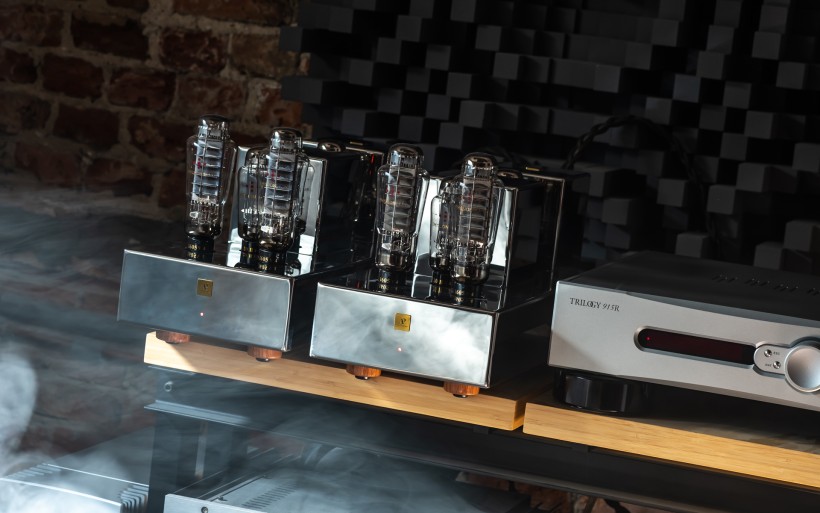 I couldn’t think of a more fitting sparring partner for the PSE1605 than Trilogy 995R monos. Both are pure class A zero-feedback designs of roughly similar power output and impedance, which makes them quite ideal for sound|kaos Vox 3 afw monitors. Four LessLoss C-MARC cords powered the contestants and Boenicke Audio IC3 CG ICs connected them to the Trilogy 915R line stage. Although hardware swaps required reconnecting some cables, there was no hardware downtime between each back and forth.
I couldn’t think of a more fitting sparring partner for the PSE1605 than Trilogy 995R monos. Both are pure class A zero-feedback designs of roughly similar power output and impedance, which makes them quite ideal for sound|kaos Vox 3 afw monitors. Four LessLoss C-MARC cords powered the contestants and Boenicke Audio IC3 CG ICs connected them to the Trilogy 915R line stage. Although hardware swaps required reconnecting some cables, there was no hardware downtime between each back and forth.
Assignments which involve class A amps are always something to look forward to. Their kind is known for particular sonic traits grouped around generous harmonic provision. That makes music vivid, packed with color, free from rough edges and enjoyable to listen to. This common ground makes class A designs somewhat similar but not identical performers. Their different output power, impedance and amplification stages largely factor in. That said, the recently reviewed Aavik I-880 integrated machine built upon a switching PSU and Toshiba bioplars driven by lateral Exicon mosfets was a monster on control, imaging size, outline specificity, torque and overall intensity. These predominant virtues went hand in hand with the usual class A perks; big tone, substance, saturation and humidity atop smoothness and resolution. For our context let’s mark the top shelf Aavik as the speedy, sensibly powerful and snappy type of the group. This transistor affair does 200wpc and has very low output impedance.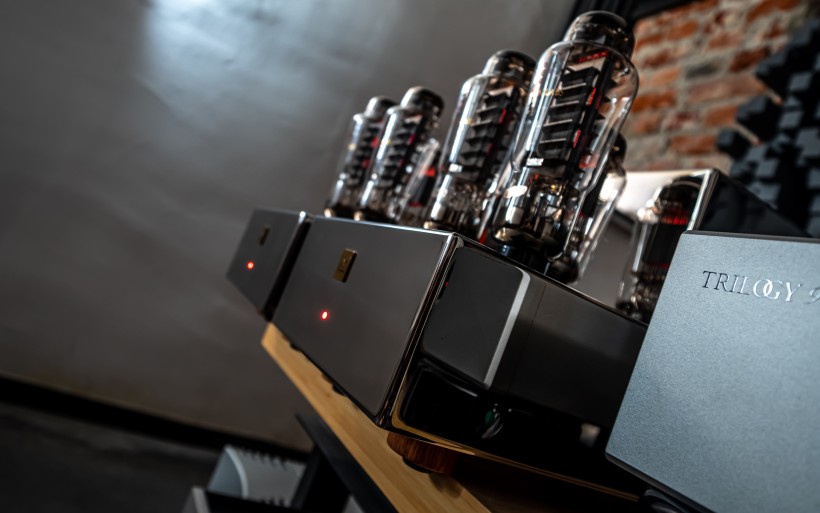 Pass Labs XA-25 locates in the middle of my class A gamut and is the breed’s poster child. That amp’s wonderfully complex personality allows it to masterfully adapt to music on the menu. On some tracks quickness and resolution emerge as its main fortes, while gravity, juiciness and color are prioritized on others. The Pass is terrific because its highly versatile profile swiftly slides from one blend of assets to another without being firmly anchored to any. This amp acts as if it can please everyone as long as it sees a suitable load. Well, at least that’s how I remember it. I also think that no matter what type of a listener you are, you’d be happy with the XA-25 in your system in one way or another. This transistor design packs 25wpc into 8Ω and has very low output impedance.
Pass Labs XA-25 locates in the middle of my class A gamut and is the breed’s poster child. That amp’s wonderfully complex personality allows it to masterfully adapt to music on the menu. On some tracks quickness and resolution emerge as its main fortes, while gravity, juiciness and color are prioritized on others. The Pass is terrific because its highly versatile profile swiftly slides from one blend of assets to another without being firmly anchored to any. This amp acts as if it can please everyone as long as it sees a suitable load. Well, at least that’s how I remember it. I also think that no matter what type of a listener you are, you’d be happy with the XA-25 in your system in one way or another. This transistor design packs 25wpc into 8Ω and has very low output impedance.
Now, upon moving all the way from the Aavik to the opposite end, and saying hello to the Pass along the road, we arrive to the atmospheric place inhabited by Trilogy 995R monos. Here copious amounts of tone, relaxation, textural fill and bass heft reign supreme and steal some spotlight mainly from articulation and clarity. The Trilogy voice comprises big spatial images busy with closely served softly outlined sound sources, meatiness, somewhat dim atmosphere and bass that hits hard yet remains pleasantly round and full. Trilogy monos punch in silk gloves just to let the audience know that a gentleman lands these blows. This tube/transistor hybrid does 55wpc into 8Ω and has low output impedance. Although these three awesome amps share the same classy backbone, each branches out in a noticeably different direction. Asking where among them locates today’s dish is the obvious question to ask. The answer is anything but straightforward. Audio Phonique PSE1605 doesn’t fit any of the above profiles yet borrows traits from each and blends them remarkably well in surprising fashion. During its first comparison to the 995R it was apparent that the Brit’s bass had harder edges and dug deeper. When that happened for the first time, I quickly labeled the PSE1605 as calmer and softer, which is a polite way of calling it lazier. That initial observation was very misleading. Although the Polish design had that range shallower and not quite as beefy, it was exceptionally elastic and anchored all across the audible range. The resulting high momentum, dynamic span, effortlessness and immediacy were its core strengths. The ‘aha!’ moment came along with understanding that today’s 2-box machine didn’t resort to using wicked bass slams to achieve this. It produced stout low end on its own right, just tailored to very nicely complement everything above this range instead of having my attention primarily there. Smart.
Although these three awesome amps share the same classy backbone, each branches out in a noticeably different direction. Asking where among them locates today’s dish is the obvious question to ask. The answer is anything but straightforward. Audio Phonique PSE1605 doesn’t fit any of the above profiles yet borrows traits from each and blends them remarkably well in surprising fashion. During its first comparison to the 995R it was apparent that the Brit’s bass had harder edges and dug deeper. When that happened for the first time, I quickly labeled the PSE1605 as calmer and softer, which is a polite way of calling it lazier. That initial observation was very misleading. Although the Polish design had that range shallower and not quite as beefy, it was exceptionally elastic and anchored all across the audible range. The resulting high momentum, dynamic span, effortlessness and immediacy were its core strengths. The ‘aha!’ moment came along with understanding that today’s 2-box machine didn’t resort to using wicked bass slams to achieve this. It produced stout low end on its own right, just tailored to very nicely complement everything above this range instead of having my attention primarily there. Smart.
During one of our many talks Maciek said that he cherishes good SET amps for their openness. It didn’t take long to get the memo. Yes, the PSE1605 cast very open highly complex spatial frames with loads of air around and in-between the key sound sources, but many costly audio products do well in this regard. This one however had that space sensibly livelier than most other amps I’ve come across, and also busy with pinpoint accurate shapes filled mainly with colors from the fruity palette, which secured the highly zesty, vibrant, moisturized and articulated view. Here the so-called tube warmth barely contributed. The PSE1605’s predominant flavor was as pleasantly sweet as it was refreshingly acidic, like a fine dish that unfolds its complex profile one layer after another and keeps constantly surprising. I honestly didn’t expect that from that sort of an amp and am willing to guess that most tube aficionados wouldn’t either. Fuzz, wobble, bloat, slowness, veil or anything else from the excessively chunky lot weren’t invited. Let me stress that my reference hybrid amps render thicker outlines and are more mellow and darker. In that sense they have more in common with the stereotypical tube voicing than today’s product, which I find quite fascinating.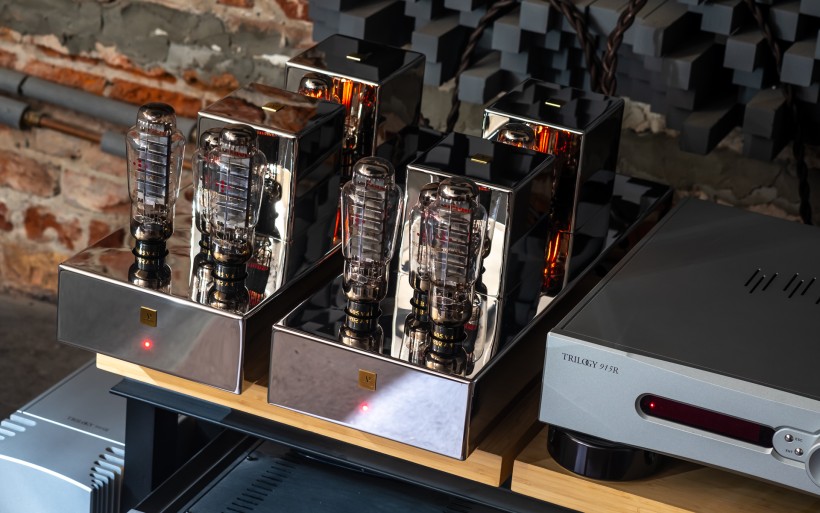 Openness, agility and tonal fruitiness are traits I usually associate with particular transistor amps. Here the Enleum AMP-23R, Nagra Classic-INT and AGD Production Vivace monos are my standouts. The PSE1605 trades in some of its already high quickness and illumination for the extra tone provision and more grounded perspective yet still scores very high on detail retrieval and clarity. The exceptional Enleum aside, my other reference tools aren’t this nuanced, precise, investigative and all around happy upstairs. The takeaway is that today’s DHT-infused team of two is groomed for posh, elegant, euphonic, organic, fresh and engaging sound, but doesn’t skip a single beat and shows tiniest dust particles without any effort at all. That’s quite the unique list of virtues, especially considering what kind of a product this is. All in all, it sounds terrific, that’s the takeaway. I also think that its cleverly executed mature profile will surprise many seasoned listeners just as it had surprised me.
Openness, agility and tonal fruitiness are traits I usually associate with particular transistor amps. Here the Enleum AMP-23R, Nagra Classic-INT and AGD Production Vivace monos are my standouts. The PSE1605 trades in some of its already high quickness and illumination for the extra tone provision and more grounded perspective yet still scores very high on detail retrieval and clarity. The exceptional Enleum aside, my other reference tools aren’t this nuanced, precise, investigative and all around happy upstairs. The takeaway is that today’s DHT-infused team of two is groomed for posh, elegant, euphonic, organic, fresh and engaging sound, but doesn’t skip a single beat and shows tiniest dust particles without any effort at all. That’s quite the unique list of virtues, especially considering what kind of a product this is. All in all, it sounds terrific, that’s the takeaway. I also think that its cleverly executed mature profile will surprise many seasoned listeners just as it had surprised me.
Purist SET amps aren’t my thing mainly because I haven’t heard many. Thöress F2A11 infused with tetrodes set as DHTs is the only standout that largely fits the profile. That review dates back to 2017, but even today I remember that its subject was no stereotypical tube charmer either. Then I praised this machine for its clarity, energy, elasticity, dynamics and immediacy just as the PSE1605 now, which also fares brilliantly on tonal elegance, spatial hydration and that particularly elusive organic vibe very few amps know how to make. Color me impressed, but come to think of it… maybe such voicing is the SET family’s well-known attractor? Maybe its aficionados will only nod and smile upon reading this story? Beats me, but today’s proposition is obviously targeted at that kind of audience and dressed to please mainly them. Deep wallets are a must, high-efficiency speakers happy about low damping are welcomed, fondness for shiny styling with exposed tubes won’t hurt. If you tick all these checkboxes, by all means try Audio Phonique PSE1605. You may really like it. I know I did!
Associated Equipment:
- Amplifier: Trilogy 995R, FirstWatt F7, Enleum AMP-23R
- DAC: LampizatOr Pacific (KR Audio T-100 / Living Voice 300B + KR Audio 5U4G Ltd. Ed.)
- Speakers: Boenicke Audio W11 SE+, sound|kaos Vox 3afw
- Transport: Innuos Statement, fidata HFAS1-S10U
- Preamplifier: Trilogy 915R, Thöress DFP
- Speaker cables: Boenicke Audio S3, LessLoss C-MARC
- Headphones: HifiMan Susvara
- Speaker signal conditioning: LessLoss Firewall for Loudspeakers, Boenicke ComDev
- Anti-vibration conditioning: 12x Carbide Audio Carbide Base (under DAC, preamp and speakers)
- Interconnects: LessLoss Entropic Process C-MARC, Boenicke Audio IC3 CG
- Power components: Gigawatt PC-3 SE EVO+/LC-3 EVO, LessLoss C-MARC, LessLoss Entropic Process C-MARC, Boenicke Audio Power Gate, ISOL-8 Prometheus
- USB components: iFi audio Mercury3.0
- Rack: Franc Audio Accesories Wood Block Rack 1+3
- Network: Fidelizer EtherStream, Linksys WRT160N
- Music: NativeDSD
Retail prices of reviewed components in EU (incl. VAT):
- Audio Phonique PSE1605: €80’000/pr
Manufacturer: Audio Phonique


